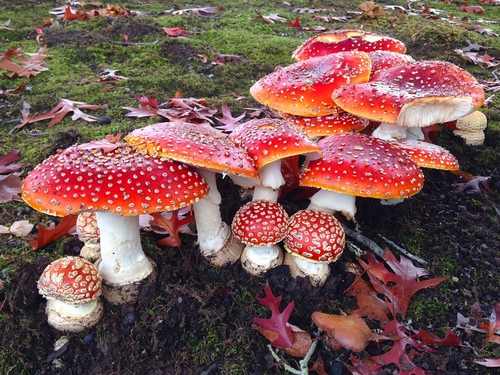Amanita muscari mushrooms, commonly known as fly agaric, are one of the most recognizable fungi in the world. With their bright red caps and white spots, these mushrooms have a long history intertwined with human culture, mythology, and tradition. In this comprehensive guide, we’ll explore the history, effects, and modern uses of Amanita muscari mushrooms.

Introduction
What Are Amanita Muscari Mushrooms?
Amanita muscari, or fly agaric, is a psychoactive mushroom known for its striking appearance and unique effects. Unlike the more commonly known psilocybin mushrooms, Amanita muscari contains different psychoactive compounds, leading to distinct experiences.
Significance in Various Cultures
Throughout history, Amanita muscari has held a place of importance in many cultures. From Siberian shamanic rituals to European folklore, these mushrooms have been revered and feared in equal measure.
Historical Background
Ancient Uses and Traditions
Amanita muscari has been used by indigenous Siberian tribes for centuries in shamanic practices. The mushrooms were believed to facilitate communication with the spirit world and were often used in religious ceremonies.
Mythology and Folklore
In European folklore, Amanita muscari is frequently associated with fairies and magical beings. It is often depicted in fairy tales and stories as a magical and mysterious element.
Identifying Amanita Muscari Mushrooms
Physical Characteristics
Amanita muscari mushrooms are easily identifiable by their bright red cap with white spots. The cap can range from 3 to 10 inches in diameter. The stem is white with a bulbous base and a skirt-like ring.
Habitat and Distribution
These mushrooms are commonly found in woodland areas, particularly under birch, pine, and spruce trees. They are widespread across the Northern Hemisphere, including North America, Europe, and Asia.
Chemical Composition
Key Psychoactive Compounds
Amanita muscari contains two primary psychoactive compounds: muscimol and ibotenic acid. These compounds interact with the brain in a way that differs significantly from psilocybin, leading to unique psychoactive effects.
Differences from Psilocybin Mushrooms
Unlike psilocybin mushrooms, which primarily affect serotonin receptors, the compounds in Amanita muscari impact GABA receptors in the brain. This results in a different set of psychological and physiological effects.
Effects of Amanita Muscari Mushrooms
Psychological Effects
Users of Amanita muscari often report experiences of euphoria, vivid dreams, and altered perception of time and space. The effects can be highly variable and are influenced by the individual’s mindset and environment.
Physiological Effects
Physiological effects can include muscle twitching, dizziness, and nausea. In some cases, higher doses can lead to more severe symptoms such as confusion and delirium.
Traditional and Modern Uses
Shamanic Practices
In traditional shamanic practices, Amanita muscari is used as a tool for spiritual exploration and healing. Shamans consume the mushrooms to enter altered states of consciousness and connect with the spiritual realm.
Contemporary Recreational Use
In modern times, some individuals use Amanita muscari recreationally. However, due to its unpredictable effects, it is less popular than psilocybin mushrooms.
Preparation and Consumption
Traditional Methods
Traditionally, Amanita muscari mushrooms were often dried and then consumed directly or made into a tea. Drying reduces the toxicity of the mushrooms and converts ibotenic acid into muscimol, which is less toxic.
Modern Techniques
Modern preparation methods include creating tinctures or extracts, which can provide a more controlled dosage. Some users also incorporate the mushrooms into foods to mask their bitter taste.
Dosage and Safety
Recommended Dosages
Dosage can vary widely depending on the potency of the mushrooms and the individual’s sensitivity. Beginners are advised to start with a small amount, such as 1 gram of dried mushroom, and gradually increase as they become more familiar with the effects.
Potential Risks and Precautions
Amanita muscari can be toxic if not prepared properly. It is crucial to ensure that the mushrooms are dried thoroughly and consumed in moderation. Users should also be aware of the legal status in their region and any potential interactions with other substances.
Legal Status of Amanita Muscari Mushrooms
International Regulations
The legal status of Amanita muscari varies globally. In some countries, they are completely legal, while others have strict regulations. It’s important to research local laws before possessing or consuming these mushrooms.
Recent Legal Developments
Recently, there has been a growing interest in the therapeutic potential of psychoactive substances, leading to changes in legislation. Some regions have begun to decriminalize or regulate the use of Amanita muscari for research purposes.
Amanita Muscari vs. Other Psychoactive Mushrooms
Comparisons with Psilocybin Mushrooms
While both Amanita muscari and psilocybin mushrooms are psychoactive, their effects and chemical compositions are different. Psilocybin mushrooms are known for their hallucinogenic properties, whereas Amanita muscari has more sedative and dreamlike effects.
Unique Characteristics
Amanita muscari’s unique characteristics, such as its striking appearance and distinct chemical makeup, set it apart from other psychoactive mushrooms. Its historical and cultural significance also adds to its uniqueness.
Research and Studies
Historical Research
Historical research on Amanita muscari has focused on its use in traditional practices and its role in various cultures. These studies provide valuable insights into its historical significance and traditional uses.
Current Scientific Studies
Current research is exploring the potential therapeutic benefits of Amanita muscari, including its effects on mental health and its potential use in treating certain conditions. These studies are still in their early stages but show promise.
Personal Stories and Testimonials
Anecdotal Experiences
Many individuals have shared their experiences with Amanita muscari, ranging from profound spiritual journeys to challenging encounters. These stories highlight the diverse effects and potential benefits of the mushroom.
Lessons Learned
Personal testimonials often emphasize the importance of preparation, setting, and mindset when using Amanita muscari. Learning from others’ experiences can help new users approach the mushroom with respect and caution.
Cultural Representation
In Art and Literature
Amanita muscari has been depicted in various forms of art and literature throughout history. Its iconic appearance and mystical properties have made it a popular symbol in fairy tales, paintings, and other creative works.
Symbolism in Popular Culture
In modern popular culture, Amanita muscari often symbolizes magic and mystery. It is frequently featured in fantasy genres and is recognized as a symbol of the unknown and the fantastical.
Conclusion
Amanita muscari mushrooms hold a unique place in the world of psychoactive substances. With their rich history, distinct effects, and ongoing research, they continue to captivate the curiosity of many. By understanding their background, effects, and proper use, you can explore the potential benefits and experiences they offer.
FAQs
Can Amanita muscari mushrooms be used safely?
Yes, but they must be prepared and consumed correctly. Proper drying and dosage are crucial to minimizing risks.
How do Amanita muscari mushrooms compare to psilocybin mushrooms?
Amanita muscari has different psychoactive compounds and effects compared to psilocybin mushrooms. It is more sedative and dreamlike rather than hallucinogenic.
Are Amanita muscari mushrooms legal?
The legal status varies by region. It’s important to check local laws before possessing or consuming these mushrooms.
What are the main active compounds in Amanita muscari?
The main active compounds are muscimol and ibotenic acid, which interact with GABA receptors in the brain.
Can Amanita muscari mushrooms be used for therapeutic purposes?
There is growing interest in their therapeutic potential, but more research is needed to fully understand their benefits and risks.
https://www.youtube.com/watch?v=gaZiXSZ_4Kw

![Magic Mushrooms near [location], [State]](https://altgecko.com/wp-content/uploads/2024/05/amanita_muscaria_for_sale-in-texas.png)
